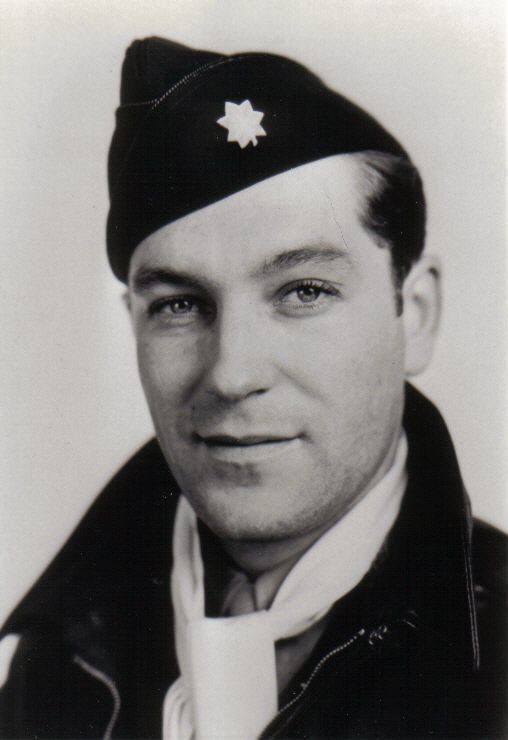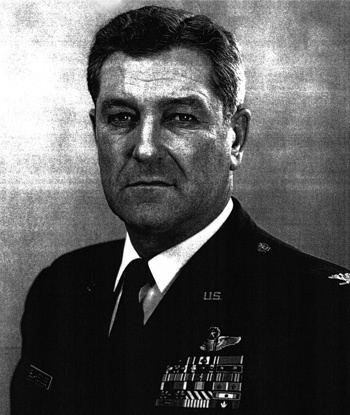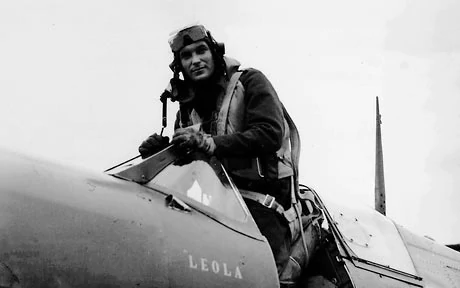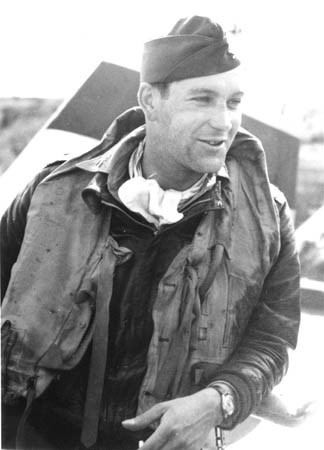Name Donald Blakeslee | ||
 | ||
Born September 11, 1917Fairport Harbor, Ohio ( 1917-09-11 ) Years of service 1941–1942 (RCAF)1942–1965 (USAF) Battles/wars World War IIKorean War Awards Distinguished Service Cross (2)Silver Star (2)Legion of MeritDistinguished Flying Cross (7)Air Medal (6)Distinguished Flying Cross (United Kingdom) Died September 3, 2008, Miami, Florida, United States Unit No. 401 Squadron RCAF, No. 133 Squadron RAF | ||
Allegiance United States of America | ||
Donald James Matthew Blakeslee (September 11, 1917 – September 3, 2008) was an officer in the United States Air Force, whose career began as a pilot in the Royal Canadian Air Force and flew Spitfire fighter aircraft, during World War II. He then became a member of the Royal Air Force Eagle squadrons. He flew more combat missions against the Luftwaffe than any other American fighter pilot.
Contents
- Early life
- RCAF and Eagle Squadrons
- 4th Fighter Group
- Awards and honors
- Personal life and death
- References

Early life

Blakeslee was born in Fairport Harbor, Ohio on September 11, 1917 and became interested in flying after watching the Cleveland Air Races as a young boy. With money saved from his job with the Diamond Alkali Company, he and a friend purchased a Piper J-3 in the mid-1930s, flying it from Willoughby Field, Ohio. However, his friend crashed the plane in 1940, and Blakeslee decided the best way to remain flying was to join the RCAF.
RCAF and Eagle Squadrons

After training in Canada, Blakeslee arrived in England on May 15, 1941, where he was assigned to No. 401 Squadron RCAF. The squadron was assigned to the Biggin Hill Wing. Flying sweeps over France, Pilot Officer Blakeslee seems to have first seen combat on November 18, 1941, when he damaged a Bf-109 near Le Touquet; and he claimed his first kill on November 22, 1941, a Bf-109 destroyed, over Desvres, about 10 miles south of Marck; on the same mission, he damaged a further Bf-109 whilst returning to base. His next kills were not claimed until April 28, 1942, two FW-190 probably destroyed. He proved to be not a particularly good shot, but was receptive to the principles involved in air fighting tactics, and was soon shown to be a gifted leader, in the air and on the ground.

By the summer of 1942 he was an acting flight lieutenant, and was awarded the British Distinguished Flying Cross on August 14, 1942. The citation read:
Acting Flight Lieutenant Donald James Mathew BLAKESLEE (Can.J/4551) Royal Canadian Air Force No. 133 (Eagle) Squadron.
This officer has completed a large number of sorties over enemy territory. He has destroyed 1, probably destroyed 2 and damaged several more hostile aircraft. He is a fine leader whose keenness has proved most inspiring.
He then completed his first tour of duty, clocking 200 combat hours with three victories.
Blakeslee had studiously avoided being part of the American volunteer Eagle Squadrons, claiming "they played sister in making their claims." But when told he would be assigned to be an instructor pilot, he finally volunteered to be sent to No. 133 (Eagle) Squadron RAF as its commanding officer, which was the only way he could remain on combat status. During the raid against Dieppe, France on August 18, 1942, Blakeslee shot down a further FW-190, and another probably destroyed on the 19th, thus achieving ace status.
4th Fighter Group
On September 12, 1942, the 71, 122, and 133 Squadrons were "activated" as the USAAF's 4th Fighter Group, operating from a former RAF field at Debden. After a few months flying Spitfires, the group was re-equipped with the new Republic P-47 Thunderbolt. On April 15, 1943 Blakeslee claimed an Fw 190 for the group's first P-47 "kill", and claimed a further Fw 190 on May 14, 1943, both near Knocke. Leading the 335th Squadron of the 4th FG, Blakeslee flew the group into Germany for the first time on July 28. Towards the end of the year, Blakeslee led the group more often, and developed a tactic of circling above any air battle and directing his fighters as necessary.
Blakeslee flew the P-51 Mustang for the first time in December 1943 and thereafter worked hard to have the 4th FG re-equipped as soon as possible with the new fighter, pushing hard, especially as he now became commanding officer of the 4th on January 1, 1944. The 8th Air Force Command eventually agreed to the request, provided the pilots were operational on the P-51 within 24 hours of receiving them. Blakeslee agreed, instructing his pilots to "learn how to fly them on the way to the target".
On March 6, 1944, Blakeslee flew in the first Mustang over Berlin while defending Boeing B-17s and Consolidated B-24s. Escorting the massed daylight raids of the 8th Air Force over Occupied Europe while under Blakeslee's command, the 4th FG became one of the highest-scoring groups of VIII Fighter Command. The 4th's aggressive style was very effective, and the 4th Fighter Group passed the 500-kill mark at the end of April 1944. At the end of the war, the group had destroyed 1,020 German planes (550 in flight, and 470 on the ground).
The next landmark for Blakeslee was leading the first "shuttle" mission to Russia on June 21, 1944, flying 1,470 miles in a mission lasting over 7 hours.
Don Blakeslee was finally grounded in September 1944, after the loss of several high-scoring USAAF aces. He had accounted for 15.5 kills in the air and 2 more on the ground. He had flown over 500 operational sorties and accumulated 1,000 combat hours. Barrett Tillman, who served as an executive secretary of the American Fighter Aces Association, stated that Blakeslee had more missions and hours "than any other American fighter pilot of World War II". Blakeslee retired from the United States Air Force in 1965 with the rank of colonel. An obituary in The Guardian further described him as: "the most decorated second world war US Army Air Force fighter pilot."
Blakeslee's personal standing among Allied pilots was considerable. British ace Johnnie Johnson described him as "one of the best leaders ever to fight over Germany".
Awards and honors
On March 6, 1944, the same day Blakeslee flew over Berlin, Dwight D. Eisenhower awarded him the Distinguished Service Cross. Blakeslee later earned another Distinguished Service Cross, as well as 7 Distinguished Flying Crosses, 2 Silver Stars, 6 Air Medals, and the British Distinguished Flying Cross. When he served in the Korean War, he also earned the Legion of Merit, an additional Distinguished Flying Cross, and four more Air Medals.
Command pilot badge
British Distinguished Flying Cross
French Croix de Guerre with Palm
Republic of Korea Presidential Unit Citation
Personal life and death
After retiring, Blakeslee lived in Miami, Florida. Blakeslee married Leola Fryer (died in 2005) in 1944 and had one daughter. Blakeslee died on September 3, 2008 at his home due to heart failure.
On Friday September 18, 2008, Colonel Don Blakeslee and his wife's ashes were interred at Arlington National Cemetery. The ceremony took place at 1100 hours and was open to the public. The 4th Fighter Wing also did a flyover at the ceremony.
